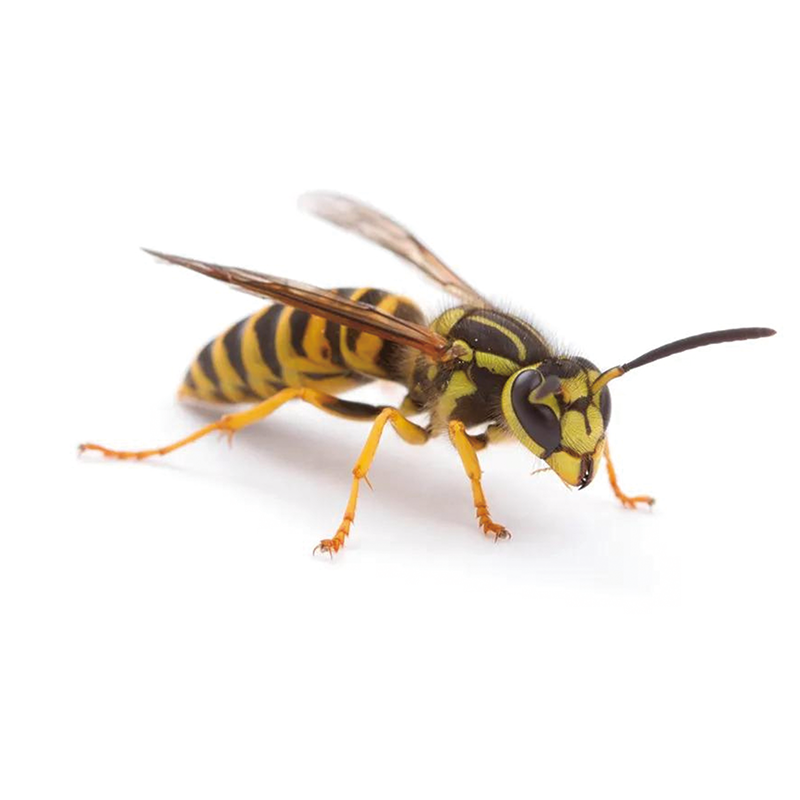
Vespula, Dolichovespula
Color: black & yellow
Size: 5/8th inch
Note: yellow jackets are incredibly dangerous to have around your home. They are able to sting their prey more than once, and it is quite painful.
What Do Yellow Jackets Look Like?
Yellowjackets, or yellow jackets, are very similar in appearance to hornets, a close relative. Yellowjackets have a smaller vertex (top margin of the head) and a narrower abdomen just behind the waist than the hornet. In North America, “yellow jacket” is the common name for predatory social wasps in the genera Vespula and Dolichovespula. In other English-speaking countries, these genera are simply called “wasps.” Most yellow jackets reach a length of about ½ an inch, while the female can reach ¾ of an inch in length. Yellowjacket workers are sometimes mistaken for bees, but yellow jackets have no hair on their bodies and do not carry pollen. They also do not have flat, hairy legs for carrying pollen, as bees do.
Are Yellow Jackets Dangerous?
Yellowjackets are territorial and will sting if they feel threatened. Unlike bees that have barbed stingers that pull out and remain in the skin, yellow jackets can sting repeatedly. Over 500,000 people are sent to the emergency room each year because they were stung by yellow jackets and other stinging insects.
While most people will only suffer a little pain for a short time when stung, someone with allergic reactions could become very sick and even die if not treated quickly. If you know you are allergic to wasp, hornet, or yellow jacket stings, please call a professional to deal with them. If you or someone near you are stung by a hornet and notice any of the following symptoms, see a doctor immediately:
- Red and itchy rash that spreads beyond the sting.
- Difficulty breathing or swallowing.
- Dizziness.
- Loss of consciousness, shock.
- Rapid pulse and arrhythmia (irregular heartbeat).
Yellow Jacket Habitats
Yellowjackets like to build their paper nests underground or in dark, open spaces like eaves or attics. Anywhere humans are, you can find yellow jackets. They can be found in urban and rural environments. Yellowjacket colonies can grow to over 4,000 workers. They are most active in late summer and early autumn. This is when their colony reaches peak numbers.
How Do I Get Rid of Yellow Jackets?
Dealing with yellow jackets can be dangerous, as they can become aggressive. It is best to stop the problem as soon as you notice them, instead of waiting to see what they will do. If you decide to try and deal with them on your own, you should wait until it gets dark. Yellowjackets return to their nest at nightfall. They will be calmer at this time. Prevention is the key to avoiding a yellow jacket problem. Rochester Pest Pro’s professional pest control technicians have been trained to identify and eliminate all kinds of wasps as well as other common household pests through our year-round preventive maintenance program. We include spraying for yellow jackets, hornets, and wasps within 10 feet of the home and up to 20 feet off the ground in our seasonal exterior spray program. Even if it is outside of regular service times, we will come back to deal with them at no charge.
How Can I Prevent Yellow Jacket Problems at My Home or Business?
Start with a routine maintenance pest program from a pest control expert like those at Rochester Pest Pro, then follow these tips to help prevent hornet problems in your home or business:
- When outside, cover food and drinks that hornets might be attracted to, especially anything sugary.
- Keep compost piles at least 20 feet from your home.
- Keep garbage cans sealed with a tight lid and at least 20 feet from your home.
- Keep hummingbird feeders away from the home.
If you suspect a yellow jacket problem, contact Rochester Pest Pro for a quote.
